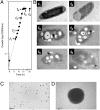A bacterial process for selenium nanosphere assembly
- PMID: 21808043
- PMCID: PMC3158160
- DOI: 10.1073/pnas.1105959108
A bacterial process for selenium nanosphere assembly
Abstract
During selenate respiration by Thauera selenatis, the reduction of selenate results in the formation of intracellular selenium (Se) deposits that are ultimately secreted as Se nanospheres of approximately 150 nm in diameter. We report that the Se nanospheres are associated with a protein of approximately 95 kDa. Subsequent experiments to investigate the expression and secretion profile of this protein have demonstrated that it is up-regulated and secreted in response to increasing selenite concentrations. The protein was purified from Se nanospheres, and peptide fragments from a tryptic digest were used to identify the gene in the draft T. selenatis genome. A matched open reading frame was located, encoding a protein with a calculated mass of 94.5 kDa. N-terminal sequence analysis of the mature protein revealed no cleavable signal peptide, suggesting that the protein is exported directly from the cytoplasm. The protein has been called Se factor A (SefA), and homologues of known function have not been reported previously. The sefA gene was cloned and expressed in Escherichia coli, and the recombinant His-tagged SefA purified. In vivo experiments demonstrate that SefA forms larger (approximately 300 nm) Se nanospheres in E. coli when treated with selenite, and these are retained within the cell. In vitro assays demonstrate that the formation of Se nanospheres upon the reduction of selenite by glutathione are stabilized by the presence of SefA. The role of SefA in selenium nanosphere assembly has potential for exploitation in bionanomaterial fabrication.
Conflict of interest statement
The authors declare no conflict of interest.
Figures





Similar articles
-
Biomineralization of selenium by the selenate-respiring bacterium Thauera selenatis.Biochem Soc Trans. 2012 Dec 1;40(6):1239-43. doi: 10.1042/BST20120087. Biochem Soc Trans. 2012. PMID: 23176461 Review.
-
An Azospira oryzae (syn Dechlorosoma suillum) strain that reduces selenate and selenite to elemental red selenium.Curr Microbiol. 2007 May;54(5):376-81. doi: 10.1007/s00284-006-0474-y. Epub 2007 May 4. Curr Microbiol. 2007. PMID: 17486405
-
Impact of selenite and selenate on differentially expressed genes in rat liver examined by microarray analysis.Biosci Rep. 2010 Apr 9;30(5):293-306. doi: 10.1042/BSR20090089. Biosci Rep. 2010. PMID: 19681755
-
Reduction of selenite to selenium nanospheres by Se(IV)-resistant Lactobacillus paralimentarius JZ07.Food Chem. 2022 Nov 1;393:133385. doi: 10.1016/j.foodchem.2022.133385. Epub 2022 Jun 2. Food Chem. 2022. PMID: 35751225
-
Metabolic pathway for selenium in the body: speciation by HPLC-ICP MS with enriched Se.Food Addit Contam. 2002 Oct;19(10):974-83. doi: 10.1080/02652030210153578. Food Addit Contam. 2002. PMID: 12443560 Review.
Cited by
-
Ecology and biotechnology of selenium-respiring bacteria.Microbiol Mol Biol Rev. 2015 Mar;79(1):61-80. doi: 10.1128/MMBR.00037-14. Microbiol Mol Biol Rev. 2015. PMID: 25631289 Free PMC article. Review.
-
Microbial Transformations of Selenium Species of Relevance to Bioremediation.Appl Environ Microbiol. 2016 Jul 29;82(16):4848-59. doi: 10.1128/AEM.00877-16. Print 2016 Aug 15. Appl Environ Microbiol. 2016. PMID: 27260359 Free PMC article. Review.
-
Complete genome sequence of Desulfurispirillum indicum strain S5(T).Stand Genomic Sci. 2011 Dec 31;5(3):371-8. doi: 10.4056/sigs.2425302. Epub 2011 Dec 22. Stand Genomic Sci. 2011. PMID: 22675586 Free PMC article.
-
Aspects of a Distinct Cytotoxicity of Selenium Salts and Organic Selenides in Living Cells with Possible Implications for Drug Design.Molecules. 2015 Jul 31;20(8):13894-912. doi: 10.3390/molecules200813894. Molecules. 2015. PMID: 26263963 Free PMC article.
-
Enhancing the Activity of Carboxymethyl Cellulase Enzyme Using Highly Stable Selenium Nanoparticles Biosynthesized by Bacillus paralicheniformis Y4.Molecules. 2022 Jul 18;27(14):4585. doi: 10.3390/molecules27144585. Molecules. 2022. PMID: 35889450 Free PMC article.
References
-
- Richardson DJ. Bacterial respiration: A flexible process for a changing environment. Microbiology. 2000;146:551–571. - PubMed
-
- Lloyd JR. Microbial reduction of metals and radionuclides. FEMS Microbiol Rev. 2003;27:411–425. - PubMed
-
- Macy JM, et al. Thauera selenatis gen-nov, sp-nov, a member of the beta-subclass of proteobacteria with a novel type of anaerobic respiration. Int J Syst Bacteriol. 1993;43:135–142. - PubMed
Publication types
MeSH terms
Substances
Associated data
- Actions
Grants and funding
LinkOut - more resources
Full Text Sources
Other Literature Sources

